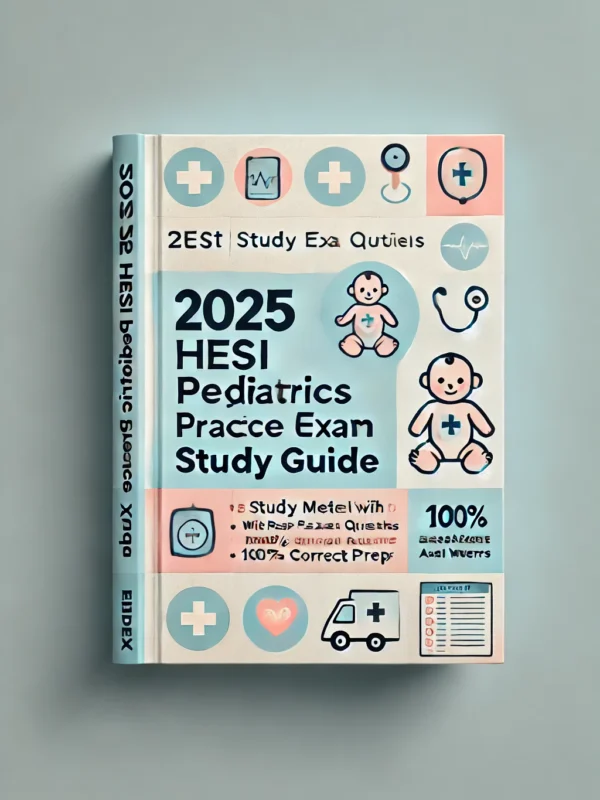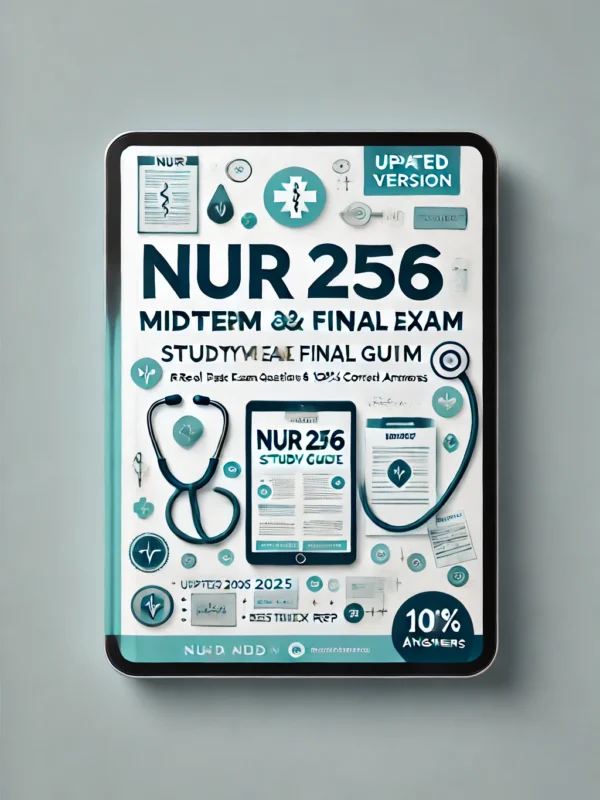Get ready for the Mental Health Nursing 2025 Exam 1 with this focused practice test, featuring 60 NCLEX-style questions and expert rationales to help you succeed. Perfect for nursing students and professionals, this resource covers critical mental health topics such as therapeutic communication, psychiatric disorders, crisis intervention, and psychopharmacology, all tailored to the 2025 exam standards. Each question is designed to mimic the NCLEX format, with detailed, expert-verified rationales to enhance your understanding and critical thinking skills. Whether you’re preparing for the NCLEX, mental health nursing certification, or classroom exams, this practice test helps you pinpoint strengths, address weaknesses, and boost confidence. Excel in mental health nursing with this essential 2025 exam prep tool.
Preview
A patient tells members of a therapy group, “I hear voices saying my doctor is poisoning
me.” Another patient replies, “I used to hear voices too. They sounded real, but I found out
later they were not. The voices you hear are not real either.” Which therapeutic factor is
exemplified in this interchange?
a. Catharsis
b. Universality
c. Imitative behavior
d. Interpersonal learning – – correct ans- -ANS: D
Here a member gains insight into his own experiences from hearing about the experiences
of others through interpersonal learning. Catharsis refers to a therapeutic discharge of
emotions. Universality refers to members realizing their feelings are common to most
people and not abnormal. Imitative behavior involves copying or borrowing the adaptive
behavior of others.
A leader plans to start a new self-esteem building group. Which intervention would be most
helpful for assuring mutual respect within the group?
a. Describe the importance of mutual respect in the first session and make it a group norm.
b. Exclude potential members whose behavior suggests they are likely to be disrespectful.
c. Give members a brochure describing the purpose, norms, and expectations of the group.
d. Explain that mutual respect is expected and confront those who are not respectful. – –
correct ans- -ANS: A
It is helpful to motivate members to behave respectfully by describing how mutual respect
benefits all members and is necessary for the group to be fully therapeutic. Setting a tone
and expectation of mutual respect from the outset is the most helpful intervention listed.
Excluding members because of how they might behave could exclude members who would
have been appropriate, depriving them of the potential benefits of the group. Conveying
expectations by brochure is less effective than doing so orally, because it lacks the
connection to each member a skilled leader can create to motivate members and impart
the expectation of respect. Confronting inappropriate behavior is therapeutic but only
addresses existing behavior rather than preventing all such undesired behavior.
A young female member in a therapy group says to an older female member, “You are just
like my mother, always trying to control me with your observations and suggestions.” Which
therapeutic factor of a group is evident by this behavior?
a. Instillation of hope
b. Existential resolution
c. Development of socializing techniques
d. Corrective recapitulation of the primary family group – – correct ans- -ANS: D
The younger patient is demonstrating an emotional attachment to the older patient that
mirrors patterns within her own family of origin, a phenomenon called corrective
recapitulation of the primary family group. Feedback from the group then helps the
member gain insight about this behavior and leads to more effective ways of relating to her
family members. Instillation of hope involves conveying optimism and sharing progress.
Existential resolution refers to the realization that certain existential experiences such as
death are part of life, aiding the adjustment to such realities. Development of socializing
techniques involves gaining social skills through the group’s feedback and practice within
the group.
me.” Another patient replies, “I used to hear voices too. They sounded real, but I found out
later they were not. The voices you hear are not real either.” Which therapeutic factor is
exemplified in this interchange?
a. Catharsis
b. Universality
c. Imitative behavior
d. Interpersonal learning – – correct ans- -ANS: D
Here a member gains insight into his own experiences from hearing about the experiences
of others through interpersonal learning. Catharsis refers to a therapeutic discharge of
emotions. Universality refers to members realizing their feelings are common to most
people and not abnormal. Imitative behavior involves copying or borrowing the adaptive
behavior of others.
A leader plans to start a new self-esteem building group. Which intervention would be most
helpful for assuring mutual respect within the group?
a. Describe the importance of mutual respect in the first session and make it a group norm.
b. Exclude potential members whose behavior suggests they are likely to be disrespectful.
c. Give members a brochure describing the purpose, norms, and expectations of the group.
d. Explain that mutual respect is expected and confront those who are not respectful. – –
correct ans- -ANS: A
It is helpful to motivate members to behave respectfully by describing how mutual respect
benefits all members and is necessary for the group to be fully therapeutic. Setting a tone
and expectation of mutual respect from the outset is the most helpful intervention listed.
Excluding members because of how they might behave could exclude members who would
have been appropriate, depriving them of the potential benefits of the group. Conveying
expectations by brochure is less effective than doing so orally, because it lacks the
connection to each member a skilled leader can create to motivate members and impart
the expectation of respect. Confronting inappropriate behavior is therapeutic but only
addresses existing behavior rather than preventing all such undesired behavior.
A young female member in a therapy group says to an older female member, “You are just
like my mother, always trying to control me with your observations and suggestions.” Which
therapeutic factor of a group is evident by this behavior?
a. Instillation of hope
b. Existential resolution
c. Development of socializing techniques
d. Corrective recapitulation of the primary family group – – correct ans- -ANS: D
The younger patient is demonstrating an emotional attachment to the older patient that
mirrors patterns within her own family of origin, a phenomenon called corrective
recapitulation of the primary family group. Feedback from the group then helps the
member gain insight about this behavior and leads to more effective ways of relating to her
family members. Instillation of hope involves conveying optimism and sharing progress.
Existential resolution refers to the realization that certain existential experiences such as
death are part of life, aiding the adjustment to such realities. Development of socializing
techniques involves gaining social skills through the group’s feedback and practice within
the group.












Reviews
There are no reviews yet.